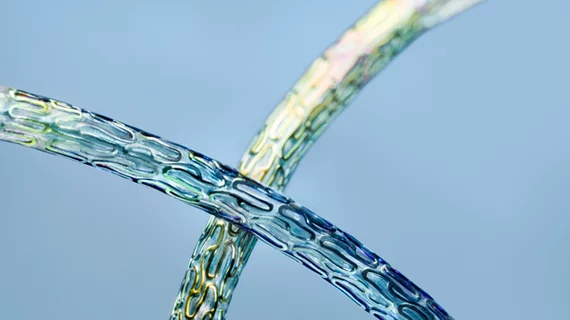New ultra-thin drug-eluting stents (DES) are associated with a 16 percent reduction in target lesion failure (TLF) at one year compared to thicker-strut, second-generation DES, according to a meta-analysis published June 26 in Circulation.
The reduction in TLF was driven by a 20 percent reduction in target vessel myocardial infarction, while the risks for cardiovascular death and ischemia-driven target lesion revascularization were similar. In addition, the ultra-thin stents were associated with a 28 percent reduction in definite, probable or possible stent thrombosis.
“The outcomes with second-generation DES, while outstanding, have plateaued and largely remained steady over the last decade and further design changes may be warranted to potentially improve outcomes,” wrote lead author Sripal Bangalore, MD, MHA, with New York University School of Medicine, and colleagues.
The researchers pooled results from 10 randomized trials containing 11,658 patients that evaluated second-generation DES versus three newer ultra-thin siroliumus-eluting stents (SES): Orsiro, MiStent and BioMime.
“Although the majority of the trials assessed the ultra-thin strut Orsiro SES vs. Xience EES (everolimus-eluting stent), tests for subgroup effects showed no effect modulation based on either the type of ultra-thin strut DES or the comparator DES used,” the authors noted, suggesting similar relative benefit for all three of the newer stents.
The struts for first-generation DES ranged from 132 μm to 140 μm, while second-generation DES used alloys such as cobalt chromium, platinum chromium or cobalt nickel which allowed for thinner struts (80-90 μm). The ultra-thin devices further dropped the thickness to 60 μm (Orsiro) to 65 μm (BioMime).
“Thinner struts afford not only greater flexibility and hence greater deliverability, but also reduce stent-induced arterial injury and inflammation, and facilitate faster endothelialization,” Bangalore et al. noted. “Moreover, thinner struts cause less turbulence and areas of low shear (stress) compared with otherwise identical thicker strut stents, with decreased thrombogenicity.”
The authors said the observed 16 percent relative reduction in TLF is what would be expected with an approximate 10 μm reduction in strut thickness.
“While the present dataset does not allow differentiation of the cause of the lower MI rate with ultra-thin DES, it is most likely attributable to the lower stent thrombosis rate observed, and potentially fewer cases of peri-procedural MI due to less side branch coverage,” they wrote.
Bangalore and colleagues pointed out sirolimus-eluting stents that weren’t ultra-thin didn’t confer better results versus other durable polymer-based second-generation stents in previous trials. Because of this, they believe their results were based on strut size rather than type of drug eluted.
Considering their results were largely driven by Orsiro versus Xience stent comparisons, the authors said the other ultra-thin DES should be evaluated in larger trials to confirm their efficacy.
“Longer-term follow-up is required to examine whether larger differences in MI or stent thrombosis between the device types will emerge over time, and whether the safety advantage of ultra-thin strut DES translates into a lower rate of cardiovascular mortality,” Bangalore et al. wrote.

